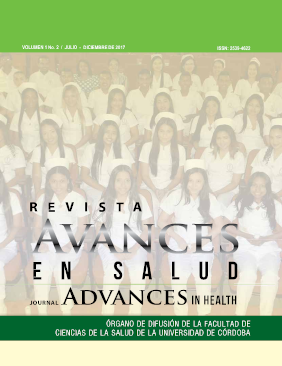Mostrar biografía de los autores
El ántrax es una zoonosis producida por Bacillus anthracis, único miembro del género Bacillus que es capaz de causar enfermedad epidémica en humanos y otros mamíferos. Afecta principalmente a los animales herbívoros domésticos y silvestres. Los humanos son hospederos accidentales y se infectan por contacto directo o indirecto con animales o productos contaminados. Las esporas pueden vivir en el suelo por años y los humanos pueden contraer el ántrax al tener contacto con animales infectados, productos provenientes de estos que al consumir carne infectada; esto se presenta principalmente en países poco desarrollados donde los niveles de vacunación animal contra esta enfermedad son bajos. Este escrito tiene por objetivo presentar una revisión sobre el tema, especialmente sobre aspectos como el modo de infección, manifestaciones clínicas, diagnóstico y tratamiento de la enfermedad.
Visitas del artículo 4022 | Visitas PDF
Descargas
- Montville TJ, Dengrove R, De Siano T, Bonnet M, Schaffner DW. Thermal resistance of spores from virulent strains of Bacillus anthracis and potential surrogates. J Food Prot. 2005;68(11):2362-2366.
- Giorno R, Bozue J, Cote C, WenzelT, Krishna SM, Mallozzi M, et al. Morphogenesis of the Bacillus anthracis spore. J Bacteriol. 2007;189(3):691-705.
- Hugh-Jones M, Blackburn J. The ecology of Bacillus anthracis. Mol Aspects Med. 2009; 30(6):356-367.
- Martin GJ, Friedlander AM. Bacillus anthracis (Anthrax). In: Mandell GL, Bennett JE, Dolin R. Principles and practice of infectious diseases. Ed 7. Philadelphia, PA: Elsevier Churchill Livingstone, 2010; 2:2715-2725.
- Van Tongeren SP, Roest HIJ, Degener JE, Harmsen HJM. Bacillus anthracis- like bacteria and their B. Cereus group members in a microbial community within the international space station: A Challenge for rapid and easy molecular detection of virulent B. anthracis. PLoS ONE. 2014;9(6): e98871. DOI:10. 1371/journal. pone.0098871.
- World Health Organization (WHO). Library cataloguing in publication data. Anthrax in humans and animals. 2008 4thEd.
- Leendertz F, Ellerbrok H, Boesch C, Couacy HE, Mätz RK, Hakenbeck R, et al. Anthrax kills wild chimpanzees in a tropical rainfo- rest. Nature.2004; 430(6998):451-452.
- Leendertz F, Yumlu S, Pauli G, Boesch C, Couacy HE, Vigilant L, et al. A new Bacillus anthracis found in wild chimpanzees and a gorilla from West and Central Africa. PLoS Pathog.2006;2(1):e8.
- Good K, Houser A, Arntzen L, Turnbull P. Naturally acquired anthrax antibodies in a cheetah (Acinonyxjubatus) in Botswana. J Wildl Dis.2008; 44(3):721-723.
- Saggese MD, Noseda RP, Uhart MM, Deem LS, Ferreyra H, Romano CN, et al. First detection of Bacillus anthracis in feces of free-ranging raptors from central Argentina. J Wildl Dis. 2007;43(1):136-141.
- Hoffmaster AR, Meyer RF, Bowen MD, Marston CK, Weyant RS, Thurman K, et al. Evaluation and validation of a real-time polymerase chain reaction assay for rapid identification of Bacillus anthracis. Emerg Infect Dis. 2002:8(10):1178-1182.
- Henderson I, Duggleby J, Turnbull C. Diffe- rentiation of Bacillus anthracis from other Bacillus cereus group bacteria with the PCR. Int J Syst Bacteriol. 1994;44: 99-105.
- Helgason E, Okstad OA, Caugant DA, Johansen HA, Fouet A, Mock M, et al. Bacillus anthracis, Bacillus cereus, and Bacillus thuringiensis - one species on the basis of the genetic evidence. Appl Environ Microbiol. 2000; 66:2627-2630.
- Center for Food Security & Public Heath (CFSPH). Institute for International Cooperation in Animal Biologics (IICAB). Anthrax. 1-9. Disponible en: http://www. cfsph.iastate.edu/Factsheets/es/antrax.pdf.
- Thapa NK, Wangdi TK, Dorji T, Dorjee MJ, Marston ChK, Hoffmaster AR. Investigation and control of anthrax outbreak at the human–animal interface, Bhutan, 2010) Emerg Infect Dis. 2014;20(9):1524-1526.
- Yamage MA. Retrospective study on the epidemiology of anthrax, foot and mouth disease, haemorrhagic septicaemia, peste des Petits ruminants and rabies in Bangladesh, 2010-2012. PLoS ONE. 2014; 9(8): e104435. doi:10.1371/journal. pone.0104435.
- Nirmal KT, Karma WT,Tshering DM, Jambay D, Chung KM, Hoffmaster AR. Investigation and Control of Anthrax Outbreak at the Human–Animal Interface, Bhutan, 2010. Emerg Infect Dis. 2014 20(9):1524–1526.
- European Centre for Disease Prevention and Control (ECDC). Annual Epidemiological Report 2011. Reporting on 2009 surveillance data and 2010 epidemic intelligence data. Stockholm: ECDC; 2011. Disponible en: http://www.ecdc.
- Ringertz SH, Hoiby EA, Jensenius M, Maehlen J, Caugant DA, Myklebust A, et al. Injectional anthrax in a heroin skin-popper. Lancet. 2000; 356(9241):1574-1575.
- Berger T, Kassirer M, Aran AA. Injectional anthrax - new presentation of an old disease. Euro Surveill. 2014;19(32):pii=20877. Disponible en: http://www.eurosurveillance.org/ ViewArticle.aspx?ArticleId=20877.
- Center for Disease Control and Prevention (CDC). Human anthrax associated with an epizootic among livestock-North Dakota, 2000. MMWR 2001;50(32):677-680.
- Peck R, Fitzgerald D. Cutaneous anthrax in the artibonite Valley of Haiti: 1992-2002. Am J Trop Med Hyg. 2007; 77(5): 806-811.
- Noseda R, Álvarez PR, Vázquez P, Combessies G, Seoane J, Pazos SBJ. Programa de alerta y respuesta ante epidemia de ocurrencia natural, accidental o deliberada de Bacillus anthracis, Azul, Provincia de Buenos Aires Argentina, Vol XXIII No, 228 Octubre 2006.
- Cabezas C, Suárez V, Vargas J, Silvia HB, Mostorino ER, Morales de SGS et al. El ántrax: Un problema de salud pública vigente. Ministerio de Salud del Perú documento técnico No 6, 2005.
- Blackburn J, McNyset K, Curtis A, Martin E, Jones H. Modeling the geographic distribution of Bacillus anthracis, the causative agent of anthrax disease, for the contiguous United States using predictive ecologic niche modeling. Am J Trop Med Hyg. 2007; 77(6): 1103-1110.
- Biswas PK, Islam MZ, Shil SK, Chakraborty RK, Ahmed SS, Christensen JP. Risk factors associated with anthrax in cattle on smallholdings. Epidemiol Infect. 2012; 140: 1888-1895.
- Chakraborty A, Khan SU, Hasnat MA, Par- veen S, Islam MS, Mikolon A, et al. Anthrax outbreaks in Bangladesh, 2009–2010. Am J Trop Med Hyg. 2012; 86: 703-710.
- Ray TK, Hutin YJ, Murhekar MV Cutaneous anthrax, West Bengal, India, 2007. Emerg Infect Dis. 2009; 15: 497-499.
- Davies JC. A major epidemic of anthrax in Zimbabwe. Cent Afr J Med. 1982;28:291- 298.
- Doganay M, Metan G. Human anthrax in Turkey from 1990 to 2007. Vector Borne Zoonotic Dis. 2009;9(2):131-140.
- Ministerio de la Protección Social, República de Colombia. Dirección General de Salud Pública Estudio de brote de carbunco cutáneo la Guajira 2010.
- Informe epidemiológico mensual. Disponible en: https://www.minsalud.gov. co/Documentos%20y%20Publicaciones/ Informe%20epidemiol%C3%B3gico%20 carbunco%20final.pdf.
- Pannucci J, Okinaka T, Sabin R, Kuske R. Bacillus anthracis pXO1 plasmid sequence conservation among closely related bacterial species. J Bacteriol. 2002; 184(1): 134-141.
- Drum CL, Yan SZ, Bard J, Shen YQ, Lu D, Soelaiman S, et al. Structural basis for the activation of anthrax Adenylyl Cyclase exotoxin by calmodulin. Nature. 2002; 415: 396-402.
- Khan MA, Gallo RM, Brutkiewicz RR. Anthrax lethal toxin impairs CD1d- mediated antigen presentation by targeting the ERK1/2 MAPK pathway. Infect Immun. 2010; 78(5):1859–1863.
- Bonuccelli G, Sotgia F, Frank PG, Williams TM, de Almeida CJ, Tanowitz HB, et al. ATR/TEM8 is highly expressed in epithelial cells lining Bacillus anthracis three sites of entry: implications for the pathogenesis of anthrax. Am J Physiol Cell Physiol. 2005; 288: 1402-1410.
- Santelli E, Bankston L, Leppla S, Liddington
- R. Crystal structure of a complex between anthrax toxin and its host cell receptor. Nature. 2004; 430(7002):905-908.
- Prince AS. The host response to anthrax lethal toxin: Unexpected observations. J Clin Invest. 2003; 112(5): 656-658.
- Lacy D, Wigelsworth D, Melnyk R, Harrison S, Collier R. Structure of heptameric protective antigen bound to an anthrax toxin receptor: a role for receptor in pH- dependent pore formation. Proceedings of the National Academy of Sciences of the United States of America 2004; 101(36):13147-13151.
- AbshireTG, Brown JE, Ezzell JW. Production and validation of the use of gamma phage for identification of Bacillus anthracis. J Clin Microbiol. 2005; 43(9):4780-4788.
- Keim P, Klevytska AM, Price LB, Schupp JM, Zinser G, Smith KL, et al. Molecular diversity in Bacillus anthracis. J Appl Microbiol. 1999;87(2):215-217.
- Ray TK, Hutin YJ, Murhekar MV. Cutaneous anthrax, West Bengal, India, 2007. Emerg Infect Dis. 2009; 15: 497-499.
- Food and Drug Administration (FDA). Doxycycline and penicillin G procaine administration for inhalational anthrax (post-exposure). Fed Reg. 2001; 2;66(213):55679-55682.
- Kammanadiminti S, Patnaikuni RK, Comer J, Meister G, Sinclair C, Kodihalli
- S. Combination therapy with antibiotics and anthrax immune globulin intravenous (AIGIV) is potentially more effective than antibiotics alone in rabbit model of inhalational anthrax. PLoS ONE. 2014; 9(9): e106393.
- Cavallo JD, Ramisse F, Girardet M, Vaissaire J, Mock M, Hernandez E. Antibiotic susceptibilities of 96 isolates of Bacillus anthracis isolated in France between 1994 and 2000. Antimicrob Agents Chemother. 2002;46(7):2307-2309.
- Agren J, Finn M, Bengtsson B, Segerman
- B. Microevolution during an anthrax outbreak leading to clonal heterogeneity and penicillin resistance. PLoS ONE. 2014; 9(2): e89112. doi:10.1371/journal. pone.0089112.
- Tessier J, Green C, Padgett D, Zhao W, Schwartz L, Hughes M, et al. Contributions of histamine, prostanoids, and neurokinins to edema elicited by edema toxin from Bacillus anthracis. Infect Immun. 2007;75(4):1895-1903.
- Jenkins A, Cote C, Twenhafel N, Merkel T, Bozue J, Welkos S. Role of purine biosynthesis in Bacillus anthracis pathogenesis and virulence. Infect. Immun. 2011;79:153-166.
- Ascough S, Ingram RJ, Chu KK, Reynolds CJ, Musson JA, Doganay M, et al. Anthrax lethal factor as an immune target in humans and transgenic mice and the impact of HLA polymorphism on CD4+ T cell immunity. PLoS Pathog.2014;10(5): e1004085.
- Kanafani ZA, Ghossain A, Sharara AI, Hatem JM, Kanj SS. Endemic gastrointestinal anthrax in 1960s Lebanon: Clinical manifestations and surgical findings. Emerg Infect Dis. 2003;9(5):520-525.
- Sirisanthana T, Brown AE. Anthrax of the gastrointestinal tract. Emerg Infect Dis. 2002;8(7):649-651.
- Beatty ME, Ashford DA, Griffin PM, Tauxe RV, Sobel J. Gastrointestinal anthrax: review of the literature. Arch Intern Med. 2003; 163(20):2527-2531.
- Dewan PK, Fry AM, Laserson KF, Tierney BC, Conrad P. Quinn CP, et al. Inhalational anthrax outbreak among postal workers, Washington, DC, 2001. Emerg Infect Dis. 2002;8(10):1066-1072.
- Doganay M, Metan G, Alp E. A review of cutaneous anthrax and its outcome. J Infect Public Health. 2010; 3:98-105 10.1016/j. jiph.2010.07.004.
- Toth DJA, Gundlapalli AV, Schell WA, Bulmahn K, Walton TE, Woods CW, et al. Quantitative models of the dose-response and time course of inhalational anthrax in humans. PLoS Pathog. 2013; 9(8): e1003555.
- Coleman ME, Thran B, Morse SS, Hugh JM, Massulik S. Inhalation anthrax: dose response and risk analysis. Biosecur Bioterror. 2008;6(2):147-160.
- Okinaka RT, Cloud K, Hampton O, Hoffmaster AR, Hill KK, Keim P, et al. Sequence and organization of pXO1, the large Bacillus anthracis plasmid harbouring the anthrax toxin genes. J. Bacteriol. 1999; 181: 6509-6515.
- Skottman T, Piiparinen H, Hyytiäinen H, Myllys V, Skurnik M, Nikkari S. Simultaneous real-time PCR detection of Bacillus anthracis, Francisella tularensis and Yersinia pestis. Eur J Clin Microbiol Infect Dis. 2007;26(3):207-211.
- Sohni Y, Kanjilal S, Kapur V. Performance evaluation of five commercial real-time PCR reagent systems using TaqMan assays for B. anthracis detection. Clin Biochem. 2008;41(7):640-644.
- Kim W, Kim JY, Cho SL, Nam SW, Shin JW, Kim YS, et al. Glycosyltransferase: A speci- fic marker for the discrimination of Bacillus anthracis from the Bacillus cereus group. J Med Microbiol. 2008;57(3):279-286.
- Gierczyński R, Zasada AA, Raddadi N, Merabishvili M, Daffonchio D, Rastawicki W, et al. Specific Bacillus anthracis identification by a plcR-targeted restriction site insertion-PCR (RSI-PCR) assay. FEMS Microbiol Lett. 2007;272(1):55-59.
- Kenefic LJ, Beaudry J, Trim C, Daly R, Parmar R, Zanecki S, et al. High-resolution genotyping of Bacillus anthracis outbreak strains using four highly mutable single nucleotide repeat markers. Lett Appl Microbiol. 2008;46(5):600-603.
- Jończyk-Matysiak E, Kłak M, Weber- Dńbrowska B, Borysowski J, Górski A. Possible use of bacteriophages active against Bacillus anthracis and other B. cereus group members in the face of a bioterrorism threat. Biomed Res Int. 2014;2014:735413. doi: 10.1155/2014/735413.
- Habrun B, Racic I, Kompes G, Spicic S, Benic M, Mihaljevic Z, et al. The antimicrobial susceptibility and virulence factors of Bacillus anthracis strains isolated in Croatia, Veterinarni Medicine. 2011; 56(1) 22-27.
- Grundmann O. The current state of bioterrorist attack surveillance and preparedness in the US review. Risk Manag Healthc Policy 2014:7 177-187.
- Kummerfeldt CE. Raxibacumab: Potential role in the treatment of inhalational anthrax. Infect Drug Resist. 2014;(7):101-109.
- Inglesby TV, O’Toole T, Henderson DA, Bartlett JG, Ascher MS, Eitzen et al. Anthrax as a biological weapon, 2002: updated recommendations for management. JAMA. 2002;287(17):2236-225.
- Niu MT, Ball R, Woo EJ, Burwen DR, Knippen M, Braun MM. Adverse events after anthrax vaccination reported to the vaccine adverse event reporting system (VAERS), 1990-2007. Vaccine. 2009;27(2):290-297.
- Meselson M, Guillemin J, Hugh-Jones M, Langmuir A, Popova I, Sheloko A, et al. The Sverdlovsk anthrax outbreak of 1979. Science. 1994;266(5188):1202-1208.
- Brookmeyer R, Blades N, Hugh-Jones M, Henderson DA. The statistical analysis of truncated data: application to the Sverdlovsk anthrax outbreak. Biostatistics. 2001;2(2):233-247.
- Bouzianas DG. Medicalcountermeasuresto protect humans from anthrax bioterrorism. Trends Microbiol. 2009; 17(11):522-528.
- Price PN, Sohn MD, Lacommare KS, McWilliams JA. Framework for evaluating anthrax risk in buildings. Environ Sci Technol. 2009; 43(6):1783-7178.








